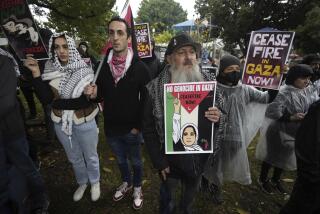Holocaust Education
- Share via
Rabbi Marvin Hier’s commentary on the Holocaust (Jan. 19) raises some very important issues about Holocaust education. He is, of course, quite correct in calling on us all--Jews and Gentiles alike--to confront the “full memory” of the unspeakable horrors of the Holocaust. It is critical to remember the “silence of the many.” It is also critical to recognize how quickly civilized men and women allowed their ignorance, their fears, their prejudices and their hatreds to turn them into willing participants in one of the most horrendous crimes in human history.
Sadly, we have daily reminders that, even today, even in the wake of the Holocaust, anti-Semitism, racism and other forms of discrimination go on all around us. We see them in large-scale ethnic conflicts across the globe or in the increasing incidence of scapegoating, hate violence and hate crime here in our own neighborhoods.
At the same time, the stories of the Schindlers, the Wallenbergs, the Sugiharas, the courage of people like Irene Opdyke or Jan and Miep Gies and others less known than these must be told. Their stories are significant not because they were the rule but precisely because they were the exception. They remind us that resistance to such inhumanity is indeed possible, that the strength to oppose it resides within each of us, and that decision to combat it begins with each of us.
These are the very lessons which are at the heart of the Anne Frank in the World exhibition, which will be at the Newport Harbor Art Museum from April 19 through June 18. Through the photographs of the exhibit itself, and through programs that will include talks by an array of survivors, rescuers and liberators, the Anne Frank exhibit will offer thousands of Orange County high school and middle school students and their families the kind of “full memory” that Rabbi Hier suggests.
BRUCE S. GIULIANO, Project Director
Orange County Anne Frank
Organizing Committee, Irvine
* There is at least one course on the Holocaust currently being taught in the Los Angeles area. Coincidentally, our class at Chaffey Community College began on Jan. 20, just one day after Rabbi Hier’s article appeared. We began the course by having the class read his article. To underscore Rabbi Hier’s contention that few have heard or learned about the Holocaust in our schools, my colleague and I asked members of the class to recount their previous Holocaust studies. Out of 25 students aged 17-40, only one had any previous classroom presentation of the Holocaust.
Your readers should also know what an extraordinary resource the Museum of Tolerance provides for Southern Californians. I have taken several of my ethics classes to the museum and our Holocaust class will visit as well. In addition, the museum arranges for Holocaust survivors to visit schools in local communities. We are pleased that two survivors have volunteered their time to help with our course at Chaffey Community College.
GARY AUROUZE, Chair
Philosophy Department
KATHLEEN BRINDELL, Professor
History Department
Chaffey College, Rancho Cucamonga
* Re “50 Years Later, Dispute Revives Auschwitz Pain,” Jan. 21:
Everyone wants a piece of Auschwitz-Birkenau. Within 30 minutes of my arrival there, in June, 1943, I asked, “Where are my mother and my little brother?” Someone pointed to the smoke in the sky, “They are burning right now and so will you very soon.” The final solution, the art of murdering as many Jews as possible in the shortest period of time, was a well-oiled piece of machinery, operating at full capacity, day and night, grinding flesh and bones into ashes. I alone remained alive out of a family of 60.
I don’t want or need any part of Auschwitz-Birkenau; let the Poles and Christian community grab as much of it as they can; let them rewrite history, explain away the disappearance of 1.5 million Jewish children, pile it all on the Nazis, transform the perpetrators, the abettors, into innocent bystanders, make the victims a figment of one’s imagination. The twisting of facts may take another 50 or 100 years, but I am sure it will be successful. I am also sure that final solution begs final judgment and that my little brother, Bernard, 10 years old, the burnt one, will be on the ultimate panel; he knows the truth.
MAURICE KORNBERG
Los Angeles
More to Read
The biggest entertainment stories
Get our big stories about Hollywood, film, television, music, arts, culture and more right in your inbox as soon as they publish.
You may occasionally receive promotional content from the Los Angeles Times.










